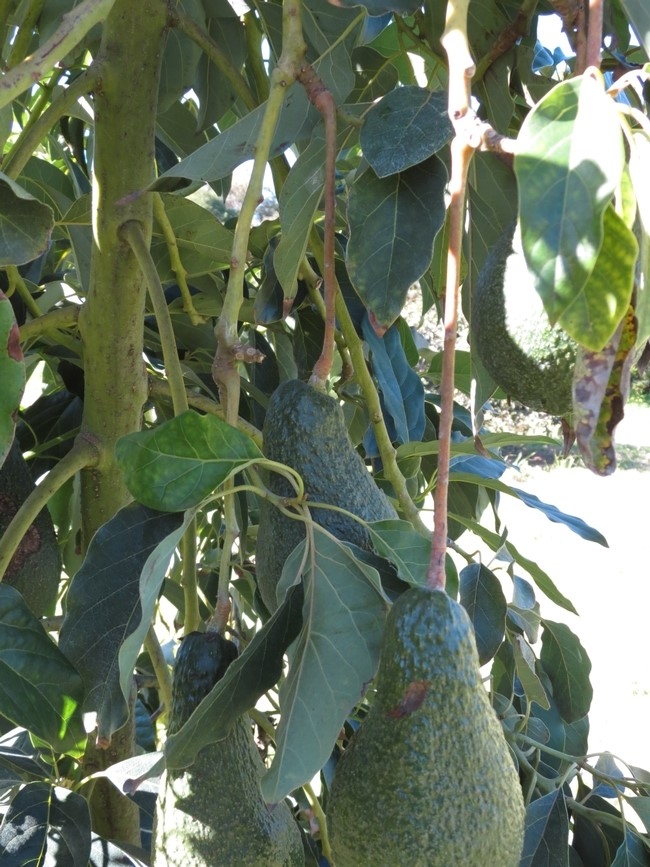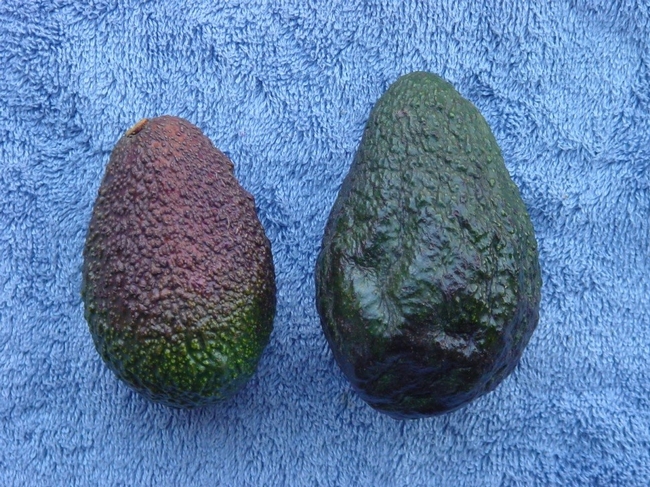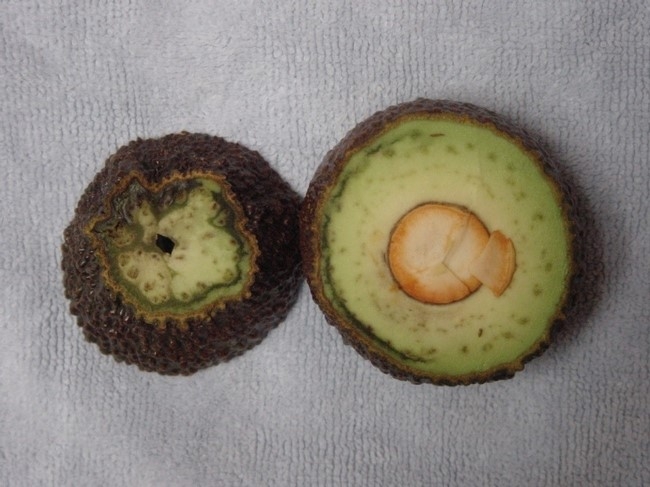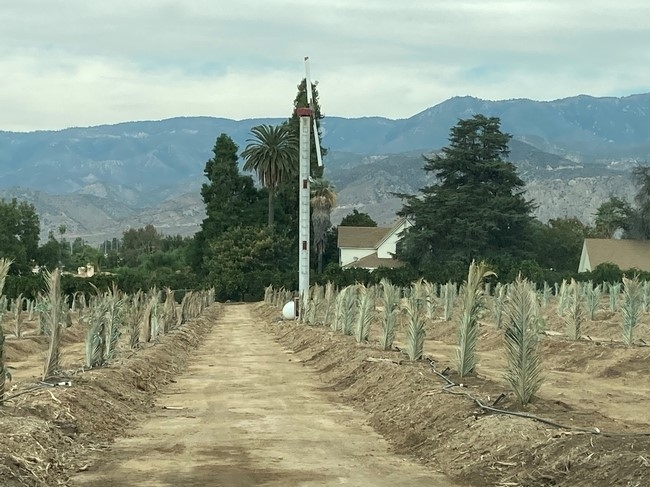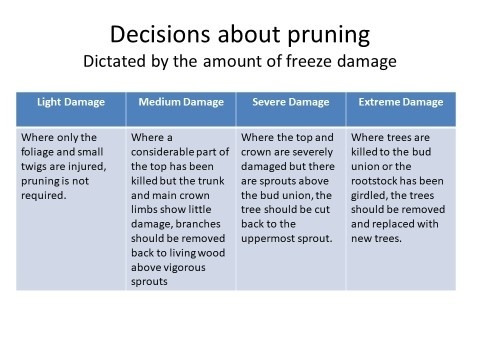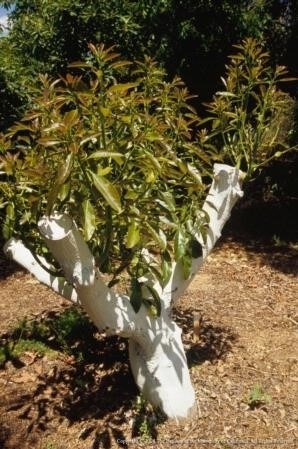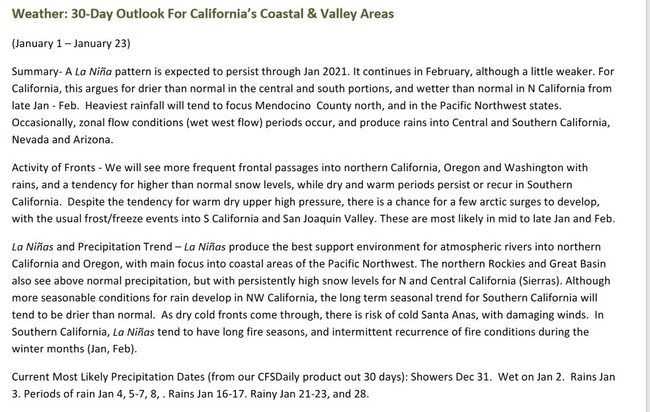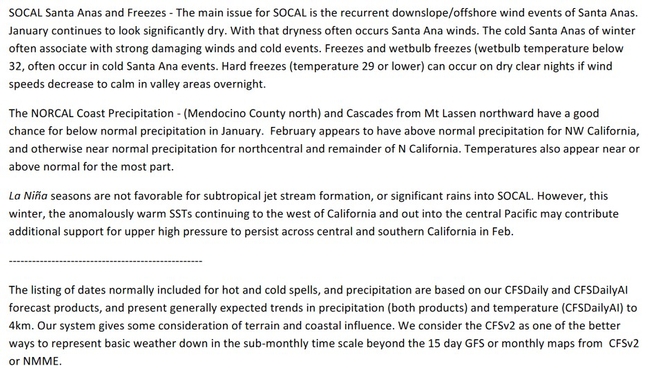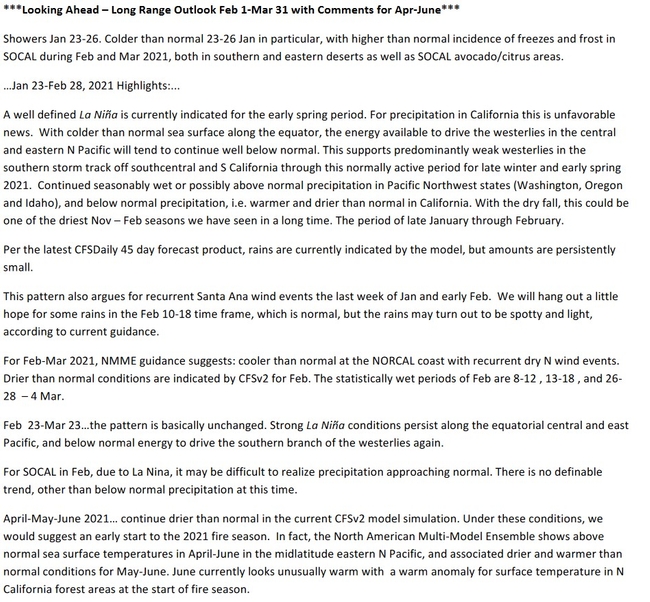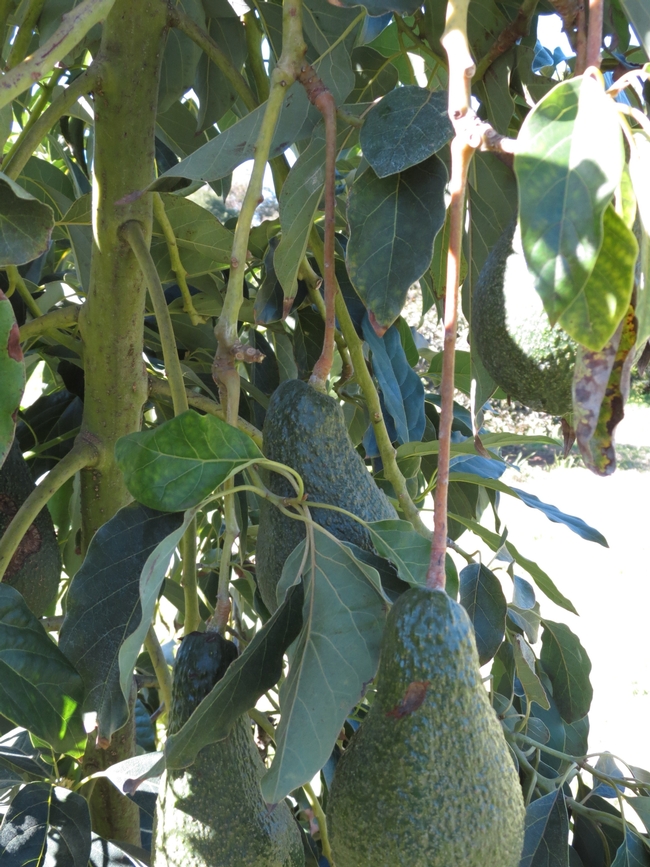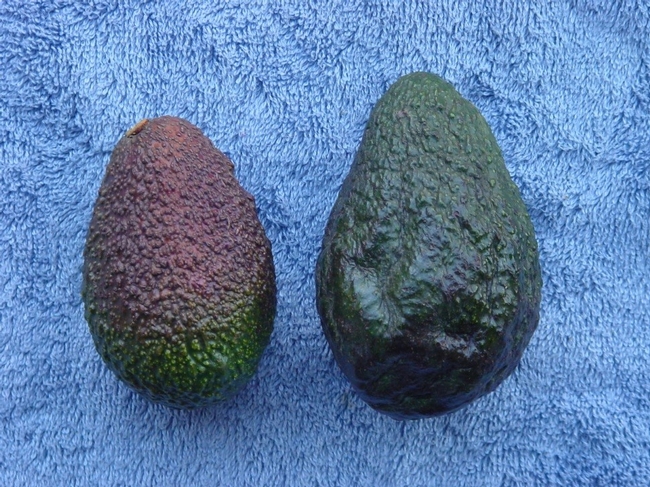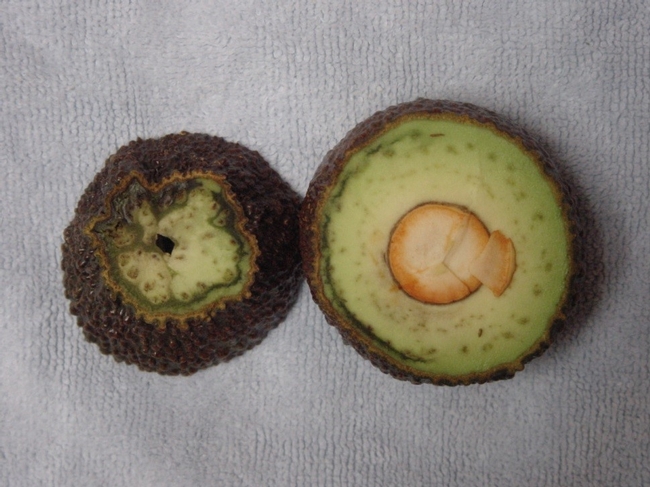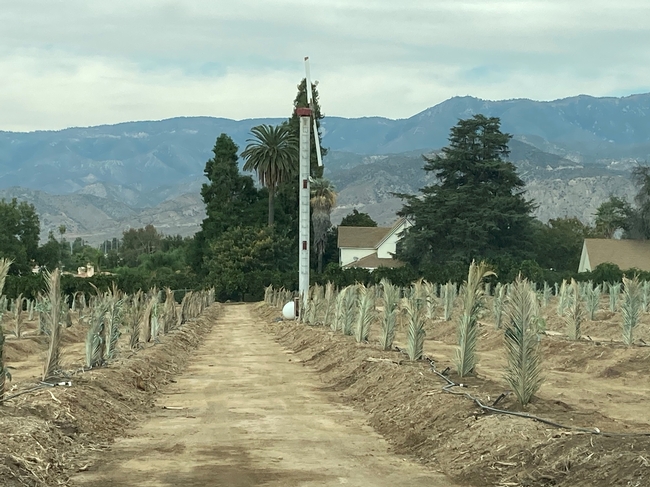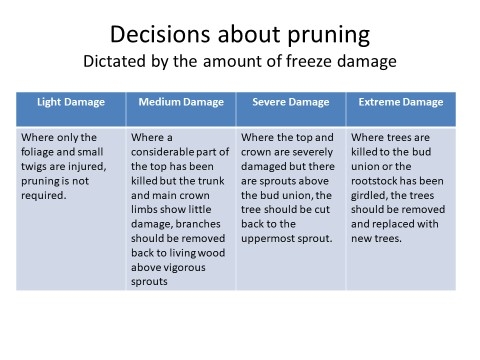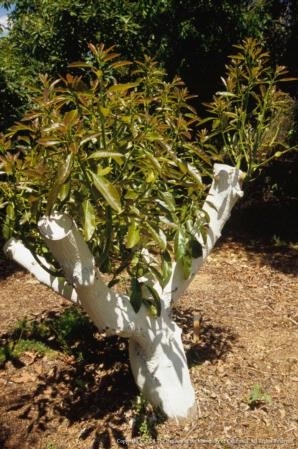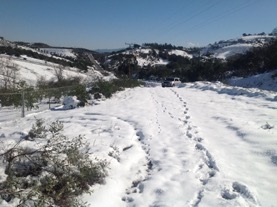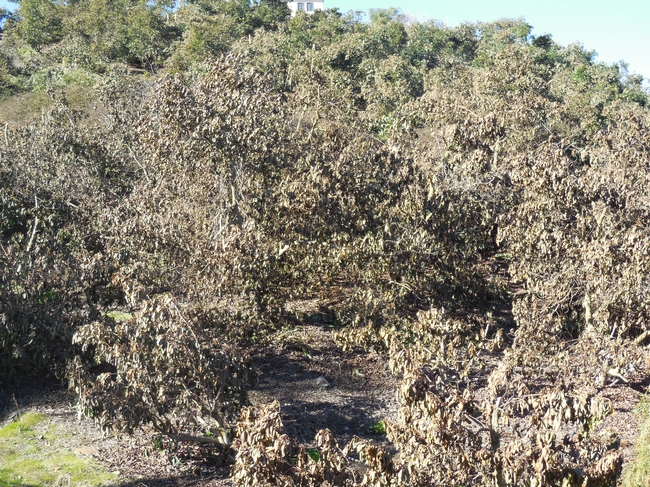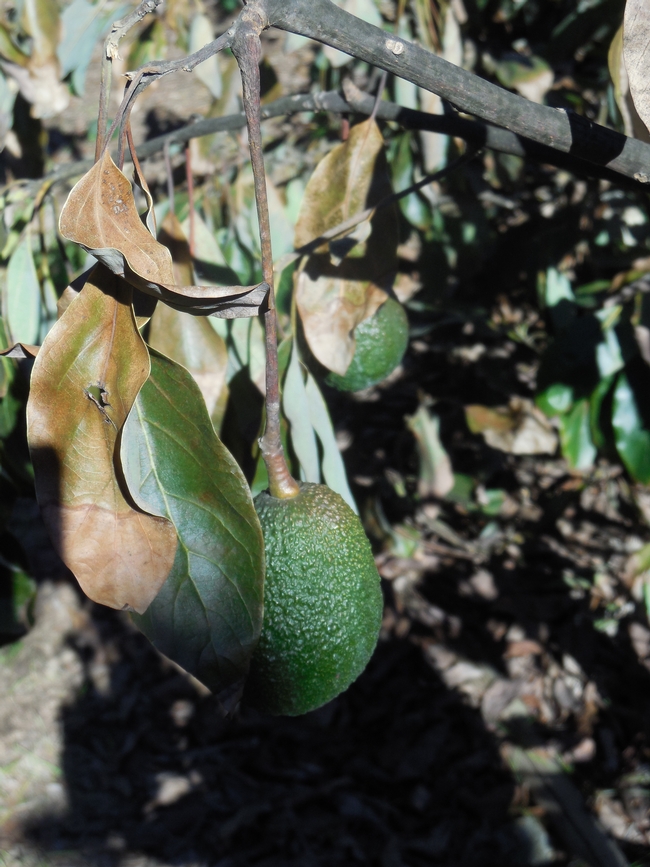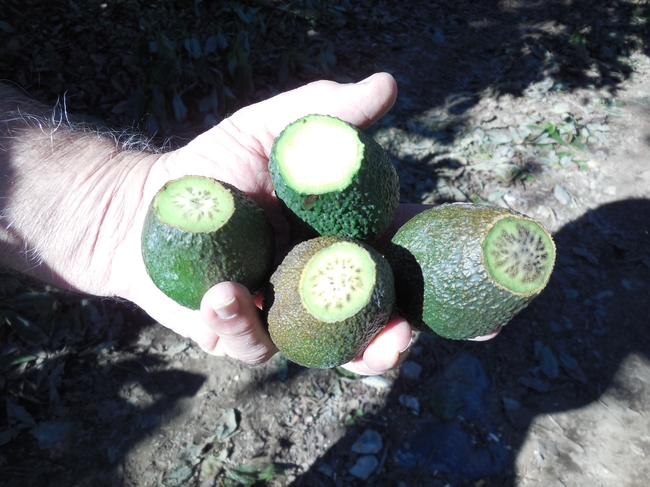Forecasts are for a mild La Nina which usually means low rainfall, cooler temperatures and relative humidities, all of which usually means greater conditions for freeze events. Watch some of these training videos from UC Davis Land Air Water Resources Department to prepare for those events:
https://lawr.ucdavis.edu/cooperative-extension/frost-protection
In the United States, the economic losses due to frost damage exceed all other weather-related phenomena. Although the economic, environmental, and social impacts of frost damage are significant on a local and global scale, the information available to the public, particularly growers, on how to avoid plant damage is insufficient. As a result, the University of California Cooperative Extension created the following narrated training units to provide growers with the scientific principles behind frosts and to demonstrate various methods to prepare for frosts and avoid plant damage. The training unit titled “Passive Frost Protection” discusses the basic definition and types of frosts, how frosts relate to atmospheric conditions, and the preventative measures that are carried out prior to a frost event to avoid or minimize damage. The training units “Active Frost Protection: Water” and “Active Frost Protection: Wind Machines” discuss the energy and labor intensive processes carried out during a frost event. The final training unit, “Methods of Measuring Temperature”, provides instructions for measuring various types of temperatures critical to frost monitoring and describes several of the frost alarm systems available to growers.ystems available to growers.
Additional features
- English and Spanish Versions
- Incorporate examples from certain types of crops with a primary focus on vineyards
Training Units :
The presentations below will run automatically on your computer, and include recorded audio.
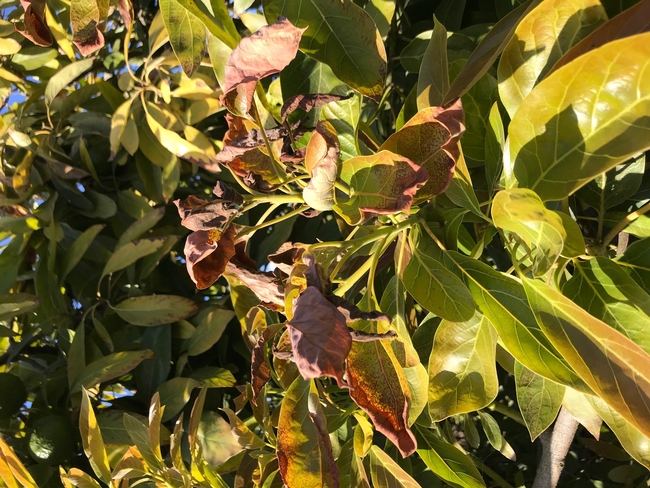
frost damage leaves
Posted on
Wednesday, October 23, 2024 at
8:07 AM
Focus Area Tags: Agriculture
Protecting Avocados from Frost and Then What
The long-range forecast is for no or little rain in Southern California. A dry winter often means a cold winter. A winter when frost and freeze can occur, And over the years, it seems like if there is a freeze in Chile in their winter, we can get one here, but 6 months later. Chile had a freeze this year.
The following is an outline of how a grower can prepare for cold events. Some require considerable advance preparation – plant the right variety – and some can be instituted right away – protection of young trees with palm fronds. The guidelines here are specific to avocado, but for the most part apply to lemon and other cold sensitive citrus.
Frost damage reduces tree growth and fruit yields. Thus, it presents a problem to the avocado grower who must develop and maintain high production to have a profitable business.
Before choosing frost protection equipment, however, the individual grower should ask the question: “Will the fruit and foliage saved pay for the trouble and expense of protection?” In some places, a small amount of damage may not fully justify the installation and operation of frost protection equipment. In other places, avocados can be grown only if expensive heating is done. Nearly all locations have sufficient cold to cause the grower to take into account probable frost damage, possible methods of protection, and the long-range economic effect of his frost situation.
How Frosts and Freeze Occur
Before considering the methods of frost protection, one should understand the conditions under which low temperatures occur. To differentiate between the two major sources of the cold, the terms local radiation frost and freeze are used.
Local radiation frost
Frosts are caused by a cooling of the objects on the earth's surface during the night. This loss of heat from the foliage and soil is called radiation. Heat accumulated from sunshine during the day is radiated to the sky during the night. The cooled objects chill the surrounding air and usually the coldest zone is near the ground surface. Air temperatures are warmer as one goes higher until a height is reached where they are at a maximum for that location. This is called the ceiling. The temperature and height of the ceiling is different for each place and situation.
When the ceiling is low, warm air is nearer the ground than when the ceiling is high. This phenomenon, occurring frequently in Southern California, is called temperature inversion and accounts for this area's ability to protect its orchards.
Colder air settles near the ground and then moves (flows) down the slope to still lower ground resulting in what is called the drift.
Terrain features and winds influence its direction and velocity. A strong drift maintains air temperatures higher than those existing when little or no drift is present.
Freeze
The other type of freezing weather occurs when a large mass of cold air moves in from the north. Fortunately, these freezes have not occurred frequently. The major ones were in 1913, 1922, 1937, 1949, and 1950. Under freeze conditions, temperatures usually go below those experienced during local radiation frosts. When this cold air moves in, high ground is no warmer than lower ground and there is little or no ceiling. Orchard protection at such time is difficult, and methods employing the addition of heat are most effective.
Measuring Temperatures
Orchard temperatures are usually measured with a specially designed self-registering minimum thermometer mounted in a standardized shelter. In this way, readings are comparable and experience allows the grower to use these air temperature readings in judging his hazard and operating his equipment. The height of the thermometer above ground should be five feet in mature orchards and two feet in nurseries and recently planted orchards.
Most orchards have areas which are colder than other areas. You should have enough thermometers to measure temperatures in each of these areas. In establishing thermometer locations in a new orchard, set up one thermometer in a permanent reference location. Move the other thermometers around every few nights until you find the cold spots. With this experience, you can locate and determine the number of thermometers needed. The range in numbers will be from a minimum of two or three for small groves to one for each three to five acres in larger orchards.
Types of Injury
Fruit damage
Fruit damage consists of frozen stems, frozen fibers inside the fruit, or frozen flesh and skin, depending on the temperatures and their duration. This damage appears slowly and is difficult to appraise accurately.
For some varieties, principally in the case of the ‘Hass', the first evidence of damage will show up as a browning on the stem a few days after a frost. If this is the only damage, mature fruit might be picked and marketed. This all depends on the packer. The problem often is assessing how extensive the damage is. Unless this fruit is harvested, it will fall from the tree. Frozen fruit of other varieties, particularly the Guatemalan types, may never show the browning but will drop anyway.
Stem Damage
Frozen fruit fibers (vascular bundles) turn black and California law prohibits the marketing of all seriously damaged fruits. Before you pick mature frosted fruit, you should call in your marketing organization representative and local agricultural inspector to help you determine how much of the fruit should be harvested. By cutting representative fruit, they can tell whether it is within the legal tolerance or not, and guide you in marketing your fruit.
Severely frozen fruit may show brown water-soaked spots in the skin, gray areas in the flesh, and may even crack or split. It is unmarketable and will drop from the tree in time.
Water soaked and frosted neck, Mary Lu Arpaia
Brown vascular bundles, Mary Lu Arpaia
Tree damage
Frozen blossoms, leaves, and twigs turn black within a few days. But larger wood, although frozen, may never turn black. Great variation occurs in the location of tree damage. In some cases, only the lower part of the tree will be frosted, while in other cases only the top part is affected. Sometimes, only a limb on one side will be frosted. Thus, it is impossible to evaluate accurately the extent of wood damage until new growth comes out the following spring and summer.
Trees suffering moderate wood damage usually will not bloom properly and will produce a reduced crop the following season. Occasionally, trees have been killed all the way to the ground by severe freezes.
Tree Resistance
The resistance of the fruit and trees to freezing temperatures helps determine whether a grove must be protected or not. Then, too, both the minimum temperature and the duration of damaging temperatures affect the amount of injury. For example, three or four hours of 29 degrees may injure an orchard more than a brief drop to 25 degrees.
Frost susceptibility varies greatly from situation to situation. Adequate appraisal of each situation should include consideration of the following variables.
Age and crowding
Young trees (up to 3 years of age) and recently top-worked trees of all varieties may be killed by temperatures which would only cause minor damage to nearby mature trees. Protection for such trees is a wise practice, even in warm locations.
In general, older trees of a given variety are more resistant, except in orchards where they are crowded. Where the soil is shaded during the day, it cannot absorb the sun's heat and thus has little heat to give off during the night. Crowding also restricts the drift through the grove and increases the difficulties of orchard heating. For these reasons, thinning groves is often advisable to reduce their frost hazard.
Health
Weak trees are more subject to frost damage than healthy ones. Be sure your trees go through the whole year with an adequate supply of moisture; withholding irrigation water in the fall to “harden them up” can actually weaken trees and make them more susceptible.
Growth flush
Occasionally avocado trees are in a growth flush (a period of rapid new growth) when freezing temperatures occur. This is not usual, but unseasonably warm weather may stimulate a tree into abnormal growth in the winter. To avoid stimulation, pruning should be delayed until early spring. When tender growth occurs in the winter, growers may have to provide additional protection or sustain damage.
Size of crop
Trees with large crops are more susceptible to frost. To save this fruit, temperatures would have to be maintained one or two degrees higher than would otherwise be necessary.
Varieties of avocado
A wide range of susceptibility occurs among avocado varieties. To classify them according to their resistance is difficult because of the variations already mentioned. But the races of avocados do exhibit differences and can be used as frost resistance indicators.
The Mexican race is the most resistant, and is able to withstand temperatures about as well as orange trees.
The Guatemalan race is the most susceptible grown in California. Some varieties are slightly more resistant than others, so the race can be divided into tender and very tender classifications. Because the fruit is immature during the winter, the crop may be lost while the trees will suffer only minor damage. Lower temperatures will seriously damage trees and affect their future productivity.
The hybrids, as typified by the Fuerte, are intermediate in their frost resistance, and are in about the same class as lemon trees. Because of the Fuerte's importance, it has become the standard measure of frost resistance. Protection is usually provided to save the Fuerte crop since the fruit is mature in the winter months.
As a guide to inexperienced growers, Table I gives a basis for establishing frost protection practices. The critical temperatures listed are for mature healthy trees. Other tree conditions might move these figures one or two degrees higher. Also, the duration of the damaging temperatures would affect the degree of injury. It is still not clear how much cold ‘GEM' variety can handle.
|
Table I – Variety Frost Resistance
|
|
Race
|
Typical Varieties
|
Critical Temperature Below Which Fruit and/or Trees are Subject to Damage
|
|
Mexican
|
Duke, Topa Topa, Mexicola, Zutano, Bacon
|
25 Degrees F
|
|
Hybrids
|
Fuerte, Puebla
|
28 Degrees F
|
|
Guatemalan (Tender)
|
Ryan, Hass, MacArthur, Nabal, Edranol, Rincon, Lamb Hass, Sir Prize
|
29 Degrees F
|
|
Guatemalan (Very Tender)
|
Anaheim, Dickinson, Carlsbad, Challenge, Hellen
|
30 Degrees F
|
Need for Protection
Frost protection is an expensive and disagreeable job which requires careful consideration by all growers. Each grower must determine his own needs. No one can predict accurately the frost hazard for a given location. Information can be obtained by installing the proper thermometers on the property. Observing adjoining orchards and talking with neighbors will give good background information.
The topography of the orchard and the surrounding land enters into the evaluation. Land on hillsides with steeper slopes is usually warmer than lower valley land. Locations with strong prevailing drifts, or exposed to winds, usually are warmer than sheltered areas having little air movement. Tall dense windbreaks can make a grove one or two degrees colder, but the lower branches of the windbreak can be trimmed to overcome this. Coastal areas usually have less frost hazard because the relative humidity is higher, and ceilings are lower than in interior areas.
As mentioned in the beginning, your final evaluation should answer this question: “Will the fruit and foliage I save pay for the trouble and expense of protection?” Often it is possible to take some damage every few years and still have a more profitable orchard than if equipment were purchased and operated. On the other hand, an investment in equipment, if properly operated, will save your trees and crops. The decision should be based on a long-range economic estimate, balancing the money lost by damage against the costs of protection. This same evaluation will determine the type of protection to provide, if needed.
In some counties and communities, smoke ordinances regulate the type of equipment and methods of operation to reduce smoke output. When you purchase new orchard heater equipment, it should be the most smokeless available in order to comply with possible future expansion or tightening of these ordinances. The trend toward eliminating smoky orchard heaters in most areas will affect the grower's choice of equipment.
Methods of Protection
Mature orchards
Only two general methods of protecting avocado groves have proved satisfactory – heaters and wind machines. A combination of these two also is used. Many makes and designs of heaters and wind machines are offered for sale and they must be compared on the basis of protection provided and cost of installation and operation. This publication is limited to their general application in avocado groves. Their actual operation is discussed in other available publications of the University of California.
Orchard heaters
Experience has shown that a large number of small fires burning throughout the orchard provide better protection than a few large fires concentrated in spots. The value of heaters is noted below to provide a basis for selecting the general type of protection needed.
Their advantages are:
- They usually furnish more adequate protection than wind machines. However, in extremely cold conditions they, too, can be inadequate.
- Only enough heaters to maintain safe temperatures need to be lighted.
- Additional heaters and oil can be stored in the field for emergency conditions.
- They distribute heat to all parts of grove.
Their disadvantages are:
- Smokiness. However, certain types have low smoke output when properly operated.
- Relatively high costs of investment and operation (Table II).
- Fire hazard due to mat of leaves beneath the trees.
- Trouble and work of operation and maintenance.
- High labor requirements.
For colder locations and positive protection, orchard heating is the only proven method. Pie line heaters, using either heater oil or natural gas under pressure from permanently installed pipelines, are efficient but very expensive. Economical and effective heating is provided by heaters with 9-gallon capacity bowls and improved designs of stacks burning a low grade of diesel oil. Usually 45 to 90 heaters are used per acre depending on the frost hazard.
Wind machines
In certain locations, wind machines have provided economical protection. Their effect is essentially that of a large fan which mixes the air within and above the orchard so that the average air temperature near the ground is raised.
Their advantages are:
- More economical than orchard heaters (Table III)
- Low labor requirements for operation
- Adequate protection against local radiation frosts when temperatures go only 2 or 3 degrees below the damaging point.
- Useful in increasing air movement in groves where dead air occurs.
- Increase effectiveness of heaters.
Their disadvantages are:
- Inadequate protection with freeze conditions or when temperatures go 4 or 5 degrees or more below the damaging point.
- Inadequate protection in locations where little or no ceiling occurs.
- Unequal protection throughout grove
- Less effective in young plantings.
Machines providing at least 5 horsepower per acre should be selected on the basis of cost and ease of operation. The location of the machine or machines in an orchard depends on the drift, the topography, and the other variables.
Combination heaters and wind machines
Usually 8 to 25 heaters per acre uniformly scattered throughout the grove are sufficient when used with an effectively installed wind machine. The combination provides adequate protection for even the colder locations. The wind machine will protect the grove for some of the nights by itself, but for the very cold nights, the heaters are available to add heat and thus provide positive protection. Usually the heaters are lighted whenever the wind machines cannot maintain the temperatures above the danger point.
This combination method has the advantage over heaters used alone in that it is cheaper, while providing as complete protection.
A great many other types and methods of protection have been tried but because of one or more faults in each, they cannot be recommended.
Protecting Young Trees
Orchard heaters and wind machines are less effective in protecting young trees in their first two or three years in the orchard than other methods which are usually cheaper, anyway. The first consideration in protecting newly planted trees is to have the trees as large as possible. Planting and topworking should be done in the spring so the trees will make the maximum growth during the summer and fall, before low temperatures occur in the winter.
In locations having serious frost hazard, you might try the practice of planting Mexican seedlings in place in the field and permitting them to grow for 2 to 3 years before topworking. Then if the topworking is done early in the spring, the young trees will have made enough growth to better withstand the cold of the following winter.
Protection for young trees is best accomplished by sheltering them from radiation heat loss. Shelters for this purpose are of many types. In cold locations, young trees may require several types of protection; they may be wrapped with paper, mounded with dirt, or surrounded with corn stalks.
Use of palm fronds for both sun and frost protection, Leo McGuire.
Care of Frost Damaged Trees
Determining the amount of damage is often a difficult job and cannot be done accurately for some months following the freeze. It is usually better to let the tree recover by itself.
Sunburn prevention
Exposed limbs can be badly damaged by sunburning. Whenever defoliated tree s have not grown enough new leaves to protect the limbs before hot weather occurs, you should provide protection.
Protection is best provided by spraying or painting all exposed limbs with either a cold-water white latex paint or a whitewash. The paint needs to be white enough to reflect the light, but thin enough to flow through a sprayer. With latex paint, a 2-part latex to 1 part water is usually adequate.
Irrigation
Do not irrigate frosted trees until the soil in the root zone approaches dryness. The loss of leaves reduces the use of water so the soil will remain wet longer than with unaffected trees. Careful, frequent examination of the soil is necessary to prevent excess moisture from normal irrigations. Avocado root rot occurs in soils with excessive moisture when the cinnamon fungus is present, and growers must guard against this disease following frost damage.
Pruning
Do no pruning until you know how much of the tree has been killed. New foliage will grow from the remaining live wood and the tree will recover better without pruning.
When new shoots are at least two or three feet long, you can remove the dead wood. This will usually be mid-summer, 6 to 8 months following the frost. At the same time, suckers should be thinned out to select the new limbs to replace those lost.
Care of young trees
Badly frozen young trees usually develop strong sucker growth which can be used to form a tree as good as a replanted tree. If these suckers are from above the bud union, you can develop a new top by thinning and training. On young trees frozen back to below the bud union, strong root suckers can be budded or grafted to the desired variety the following spring. If the sucker growth is weak, the tree should be removed.
Severely frozen mature trees
The handling of severely frozen mature trees where they have been killed back to the large scaffold limbs, to the trunk, or to the ground, presents many problems. Each tree should be considered separately. Often growers should topwork badly frozen trees to a more resistant or productive variety.
Whitewashed and topworked frozen tree
And a lot more information from the CA Avocado Commission
Frost and Frost Protection Source of Information
You wanted to know all about Frost, well it's all here. Emeritus Rick Snyder put it together over the years and it's at your finger tips.
English Frost Protection Training Units (videos)
Spanish Frost Protection Training Units (videos)
When to Turn Sprinklers On and Off for Frost Protection
FP001 Quick Answer—This quick answer provides information on using a psychrometer or temperature and dew point data to determine when to start and start sprinklers for frost protection.
Predicting Temperature Trends during Freeze Nights
FP002 Quick Answer—This quick answer gives a method for predicting the change in
temperature during a calm, radiation freeze night.
A Simple Method to Measure the Dew Point Temperature
FP003 Quick Answer—This quick answer provides information on how to measure the dew point for use in estimating minimum temperature and for starting and stopping
sprinklers for frost protection.
Sprinkler Application Rates for Freeze Protection
FP004 Quick Answer—This quick answer provides information on the sprinkler
application (precipitation) rates needed to protect crops from freezing.
Principles of Frost Protection
Frost Protection Training Units (videos) on measuring temperature, frost protection with water, frost protection with wind machines, and passive protection. Traning units are availble in English and Spanish .
FP005 Quick Answer—This quick answer provides information on the general principles of well-known frost protection methods. A PDF file of the WEB page can be uploaded from this Quick Answer. In addition, a shorter version is available.
Programs for Estimating Frost Night Minimum Temperatures and Temperature Trends (new 7 Mar 2007)
The FFST Excel application programs FFST_E.xls and FFST_M.xls are available from this link. The FFST application helps users to determine an empirical equation for estimating minimum temperatures during radiation frost nights. Note that the program will provide good estimates if there is little or no wind, no significant cold air drainage, and no clouds.
The FTrend Excel application programs FTrend_E.xls and FTrend_M.xls are available from this link. The FTrend application program is used for estimating changes in air and wet-bulb temperatures during a frost night. The application is useful for predicting when to start sprinklers for frost protection and for other methods as well.
Estimating Risk of Frost Damage from Climate Data (new 8 Jul 2006)
One of the programs included with the book Frost protection: fundamentals, practice, and economics. Volume 2, which is available from the UN FAO is the Frisk program. Information on how to obtain the book is presented above on this web page. Based on reader feedback, some improvements have been made to the Frisk application since the book was published. Updated versions of the application are made available to the public here. The Frisk program is an MS Excel application that is designed to help growers to make decisions on the risk of frost damage in a particular location. The user inputs the local climate data and a critical damage temperature, and the application computes the probability of temperature falling below the critical temperature on each day of the year. These data are then used to estimate the length of the growing season relative to the critical temperature by presenting a graph of the probability that the growing season will be less than a specific number of days. The application also computes the certainty that no air temperature will fall below the critical damage temperature after a selected date in the spring or before a selected date in the fall for design periods of 5, 10, …, 30 years. This certainty of no events is equivalent to the risk of having one or more events during the same time period. Although Celsius temperature was used in the example application programs, the program works equally well using Fahrenheit temperature. To obtain a copy of the application, click on FriskNH.xls for the northern hemisphere or FriskSH.xls for the southern hemisphere. Note that metric units were used in the Frisk application sample data.
Public Value: UCANR: Promoting economic prosperity in California
Posted on
Tuesday, December 20, 2022 at
8:01 AM
Focus Area Tags: Agriculture
A moderate La Niña climate phase is expected through spring 2021. This indicates that slightly above average temperatures and slightly less rainfall than normal can be expected in California's avocado/lemon growing areas.
The fact that the winter weather pattern is expected to be warmer than usual doesn't rule out the possibility of a freeze. A freeze can occur any winter, regardless of the climate phase. And dry winters are often susceptible to sudden cold spells because of the lack of tempering effect of soil wet from winter rains
La Niña is one of three climate phases that are part of the El Niño Southern Oscillation (ENSO) climate pattern. Others are El Niño, during which colder and wetter conditions are expected in California, and neutral, when conditions are neither El Niño nor La Niña.
California's most severe freezes have occurred in weak La Niña, weak El Niño or neutral ENSO phases. Severe freezes in Decembers of 1990, 1998, 2001 and 2006 occurred after droughty years and years of low rainfall. In 2015, it snowed in Temecula and again in 2020 – in February!!! So cold weather is still waiting out there.
The most damaging freezes for avocado and citrus are advection and radiation freezes. In advection freezes, cold fronts move arctic air through the region. Radiation freezes feature overnight clear skies and light to no winds with periods of calm. Cold pockets and cold locations will have lower temperatures during radiation freezes. Break freezes and unsettled freezes are the other types of freezes.
During a radiation freeze, cold air drains down and pools in low areas. Know the cold pockets in your grove, and keep that air flowing with a wind machine, if possible.
Read the collected works on frost protection, frost damage and frost recovery here:
https://www.californiaavocadogrowers.com/growing/cultural-management-library/freeze-protection
It's also a good idea to be ready for fires in years of low/no rainfall.
The 2021 Weather Forecast from Fox Weather provided by CAC is below:
Image: Temecula snow on avocados in February
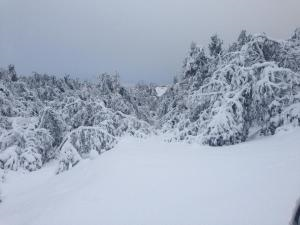
avocado snow Temecula
Posted on
Wednesday, January 13, 2021 at
6:46 AM
Focus Area Tags: Agriculture
Protecting Avocados from Frost and Then What
The long-range forecast for no or little rain in Southern California. A dry winter often means a cold winter. A winter when frost and freeze can occur - https://www.californiaavocadogrowers.com/sites/default/files/greensheet-pdfs/Greensheet-Nov-2-2020.pdf
The following is an outline of how a grower can prepare for cold events. Some require considerable advance preparation – plant the right variety – and some can be instituted right away – protection of young trees with palm fronds. The guidelines here are specific to avocado, but for the most part apply to lemon and other cold sensitive citrus.
Frost damage reduces tree growth and fruit yields. Thus, it presents a problem to the avocado grower who must develop and maintain high production to have a profitable business.
Before choosing frost protection equipment, however, the individual grower should ask the question: “Will the fruit and foliage saved pay for the trouble and expense of protection?” In some places, a small amount of damage may not fully justify the installation and operation of frost protection equipment. In other places, avocados can be grown only if expensive heating is done. Nearly all locations have sufficient cold to cause the grower to take into account probable frost damage, possible methods of protection, and the long-range economic effect of his frost situation.
How Frosts and Freeze Occur
Before considering the methods of frost protection, one should understand the conditions under which low temperatures occur. To differentiate between the two major sources of the cold, the terms local radiation frost and freeze are used.
Local radiation frost
Frosts are caused by a cooling of the objects on the earth's surface during the night. This loss of heat from the foliage and soil is called radiation. Heat accumulated from sunshine during the day is radiated to the sky during the night. The cooled objects chill the surrounding air and usually the coldest zone is near the ground surface. Air temperatures are warmer as one goes higher until a height is reached where they are at a maximum for that location. This is called the ceiling. The temperature and height of the ceiling is different for each place and situation.
When the ceiling is low, warm air is nearer the ground than when the ceiling is high. This phenomenon, occurring frequently in Southern California, is called temperature inversion and accounts for this area's ability to protect its orchards.
Colder air settles near the ground and then moves (flows) down the slope to still lower ground resulting in what is called the drift.
Terrain features and winds influence its direction and velocity. A strong drift maintains air temperatures higher than those existing when little or no drift is present.
Freeze
The other type of freezing weather occurs when a large mass of cold air moves in from the north. Fortunately, these freezes have not occurred frequently. The major ones were in 1913, 1922, 1937, 1949, and 1950. Under freeze conditions, temperatures usually go below those experienced during local radiation frosts. When this cold air moves in, high ground is no warmer than lower ground and there is little or no ceiling. Orchard protection at such time is difficult, and methods employing the addition of heat are most effective.
Measuring Temperatures
Orchard temperatures are usually measured with a specially designed self-registering minimum thermometer mounted in a standardized shelter. In this way, readings are comparable and experience allows the grower to use these air temperature readings in judging his hazard and operating his equipment. The height of the thermometer above ground should be five feet in mature orchards and two feet in nurseries and recently planted orchards.
Most orchards have areas which are colder than other areas. You should have enough thermometers to measure temperatures in each of these areas. In establishing thermometer locations in a new orchard, set up one thermometer in a permanent reference location. Move the other thermometers around every few nights until you find the cold spots. With this experience, you can locate and determine the number of thermometers needed. The range in numbers will be from a minimum of two or three for small groves to one for each three to five acres in larger orchards.
Types of Injury
Fruit damage
Fruit damage consists of frozen stems, frozen fibers inside the fruit, or frozen flesh and skin, depending on the temperatures and their duration. This damage appears slowly and is difficult to appraise accurately.
For some varieties, principally in the case of the ‘Hass', the first evidence of damage will show up as a browning on the stem a few days after a frost. If this is the only damage, mature fruit might be picked and marketed. This all depends on the packer. The problem often is assessing how extensive the damage is. Unless this fruit is harvested, it will fall from the tree. Frozen fruit of other varieties, particularly the Guatemalan types, may never show the browning but will drop anyway.
Stem Damage
Frozen fruit fibers (vascular bundles) turn black and California law prohibits the marketing of all seriously damaged fruits. Before you pick mature frosted fruit, you should call in your marketing organization representative and local agricultural inspector to help you determine how much of the fruit should be harvested. By cutting representative fruit, they can tell whether it is within the legal tolerance or not, and guide you in marketing your fruit.
Severely frozen fruit may show brown water-soaked spots in the skin, gray areas in the flesh, and may even crack or split. It is unmarketable and will drop from the tree in time.
Water soaked and frosted neck, Mary Lu Arpaia
Brown vascular bundles, Mary Lu Arpaia
Tree damage
Frozen blossoms, leaves, and twigs turn black within a few days. But larger wood, although frozen, may never turn black. Great variation occurs in the location of tree damage. In some cases, only the lower part of the tree will be frosted, while in other cases only the top part is affected. Sometimes, only a limb on one side will be frosted. Thus, it is impossible to evaluate accurately the extent of wood damage until new growth comes out the following spring and summer.
Trees suffering moderate wood damage usually will not bloom properly and will produce a reduced crop the following season. Occasionally, trees have been killed all the way to the ground by severe freezes.
Tree Resistance
The resistance of the fruit and trees to freezing temperatures helps determine whether a grove must be protected or not. Then, too, both the minimum temperature and the duration of damaging temperatures affect the amount of injury. For example, three or four hours of 29 degrees may injure an orchard more than a brief drop to 25 degrees.
Frost susceptibility varies greatly from situation to situation. Adequate appraisal of each situation should include consideration of the following variables.
Age and crowding
Young trees (up to 3 years of age) and recently top-worked trees of all varieties may be killed by temperatures which would only cause minor damage to nearby mature trees. Protection for such trees is a wise practice, even in warm locations.
In general, older trees of a given variety are more resistant, except in orchards where they are crowded. Where the soil is shaded during the day, it cannot absorb the sun's heat and thus has little heat to give off during the night. Crowding also restricts the drift through the grove and increases the difficulties of orchard heating. For these reasons, thinning groves is often advisable to reduce their frost hazard.
Health
Weak trees are more subject to frost damage than healthy ones. Be sure your trees go through the whole year with an adequate supply of moisture; withholding irrigation water in the fall to “harden them up” can actually weaken trees and make them more susceptible.
Growth flush
Occasionally avocado trees are in a growth flush (a period of rapid new growth) when freezing temperatures occur. This is not usual, but unseasonably warm weather may stimulate a tree into abnormal growth in the winter. To avoid stimulation, pruning should be delayed until early spring. When tender growth occurs in the winter, growers may have to provide additional protection or sustain damage.
Size of crop
Trees with large crops are more susceptible to frost. To save this fruit, temperatures would have to be maintained one or two degrees higher than would otherwise be necessary.
Varieties of avocado
A wide range of susceptibility occurs among avocado varieties. To classify them according to their resistance is difficult because of the variations already mentioned. But the races of avocados do exhibit differences and can be used as frost resistance indicators.
The Mexican race is the most resistant, and is able to withstand temperatures about as well as orange trees.
The Guatemalan race is the most susceptible grown in California. Some varieties are slightly more resistant than others, so the race can be divided into tender and very tender classifications. Because the fruit is immature during the winter, the crop may be lost while the trees will suffer only minor damage. Lower temperatures will seriously damage trees and affect their future productivity.
The hybrids, as typified by the Fuerte, are intermediate in their frost resistance, and are in about the same class as lemon trees. Because of the Fuerte's importance, it has become the standard measure of frost resistance. Protection is usually provided to save the Fuerte crop since the fruit is mature in the winter months.
As a guide to inexperienced growers, Table I gives a basis for establishing frost protection practices. The critical temperatures listed are for mature healthy trees. Other tree conditions might move these figures one or two degrees higher. Also, the duration of the damaging temperatures would affect the degree of injury. It is still not clear how much cold ‘GEM' variety can handle.
|
Table I – Variety Frost Resistance
|
|
Race
|
Typical Varieties
|
Critical Temperature Below Which Fruit and/or Trees are Subject to Damage
|
|
Mexican
|
Duke, Topa Topa, Mexicola, Zutano, Bacon
|
25 Degrees F
|
|
Hybrids
|
Fuerte, Puebla
|
28 Degrees F
|
|
Guatemalan (Tender)
|
Ryan, Hass, MacArthur, Nabal, Edranol, Rincon, Lamb Hass, Sir Prize
|
29 Degrees F
|
|
Guatemalan (Very Tender)
|
Anaheim, Dickinson, Carlsbad, Challenge, Hellen
|
30 Degrees F
|
Need for Protection
Frost protection is an expensive and disagreeable job which requires careful consideration by all growers. Each grower must determine his own needs. No one can predict accurately the frost hazard for a given location. Information can be obtained by installing the proper thermometers on the property. Observing adjoining orchards and talking with neighbors will give good background information.
The topography of the orchard and the surrounding land enters into the evaluation. Land on hillsides with steeper slopes is usually warmer than lower valley land. Locations with strong prevailing drifts, or exposed to winds, usually are warmer than sheltered areas having little air movement. Tall dense windbreaks can make a grove one or two degrees colder, but the lower branches of the windbreak can be trimmed to overcome this. Coastal areas usually have less frost hazard because the relative humidity is higher, and ceilings are lower than in interior areas.
As mentioned in the beginning, your final evaluation should answer this question: “Will the fruit and foliage I save pay for the trouble and expense of protection?” Often it is possible to take some damage every few years and still have a more profitable orchard than if equipment were purchased and operated. On the other hand, an investment in equipment, if properly operated, will save your trees and crops. The decision should be based on a long-range economic estimate, balancing the money lost by damage against the costs of protection. This same evaluation will determine the type of protection to provide, if needed.
In some counties and communities, smoke ordinances regulate the type of equipment and methods of operation to reduce smoke output. When you purchase new orchard heater equipment, it should be the most smokeless available in order to comply with possible future expansion or tightening of these ordinances. The trend toward eliminating smoky orchard heaters in most areas will affect the grower's choice of equipment.
Methods of Protection
Mature orchards
Only two general methods of protecting avocado groves have proved satisfactory – heaters and wind machines. A combination of these two also is used. Many makes and designs of heaters and wind machines are offered for sale and they must be compared on the basis of protection provided and cost of installation and operation. This publication is limited to their general application in avocado groves. Their actual operation is discussed in other available publications of the University of California.
Orchard heaters
Experience has shown that a large number of small fires burning throughout the orchard provide better protection than a few large fires concentrated in spots. The value of heaters is noted below to provide a basis for selecting the general type of protection needed.
Their advantages are:
- They usually furnish more adequate protection than wind machines. However, in extremely cold conditions they, too, can be inadequate.
- Only enough heaters to maintain safe temperatures need to be lighted.
- Additional heaters and oil can be stored in the field for emergency conditions.
- They distribute heat to all parts of grove.
Their disadvantages are:
- Smokiness. However, certain types have low smoke output when properly operated.
- Relatively high costs of investment and operation (Table II).
- Fire hazard due to mat of leaves beneath the trees.
- Trouble and work of operation and maintenance.
- High labor requirements.
For colder locations and positive protection, orchard heating is the only proven method. Pie line heaters, using either heater oil or natural gas under pressure from permanently installed pipelines, are efficient but very expensive. Economical and effective heating is provided by heaters with 9-gallon capacity bowls and improved designs of stacks burning a low grade of diesel oil. Usually 45 to 90 heaters are used per acre depending on the frost hazard.
Wind machines
In certain locations, wind machines have provided economical protection. Their effect is essentially that of a large fan which mixes the air within and above the orchard so that the average air temperature near the ground is raised.
Their advantages are:
- More economical than orchard heaters (Table III)
- Low labor requirements for operation
- Adequate protection against local radiation frosts when temperatures go only 2 or 3 degrees below the damaging point.
- Useful in increasing air movement in groves where dead air occurs.
- Increase effectiveness of heaters.
Their disadvantages are:
- Inadequate protection with freeze conditions or when temperatures go 4 or 5 degrees or more below the damaging point.
- Inadequate protection in locations where little or no ceiling occurs.
- Unequal protection throughout grove
- Less effective in young plantings.
Machines providing at least 5 horsepower per acre should be selected on the basis of cost and ease of operation. The location of the machine or machines in an orchard depends on the drift, the topography, and the other variables.
Combination heaters and wind machines
Usually 8 to 25 heaters per acre uniformly scattered throughout the grove are sufficient when used with an effectively installed wind machine. The combination provides adequate protection for even the colder locations. The wind machine will protect the grove for some of the nights by itself, but for the very cold nights, the heaters are available to add heat and thus provide positive protection. Usually the heaters are lighted whenever the wind machines cannot maintain the temperatures above the danger point.
This combination method has the advantage over heaters used alone in that it is cheaper, while providing as complete protection.
A great many other types and methods of protection have been tried but because of one or more faults in each, they cannot be recommended.
Protecting Young Trees
Orchard heaters and wind machines are less effective in protecting young trees in their first two or three years in the orchard than other methods which are usually cheaper, anyway. The first consideration in protecting newly planted trees is to have the trees as large as possible. Planting and topworking should be done in the spring so the trees will make the maximum growth during the summer and fall, before low temperatures occur in the winter.
In locations having serious frost hazard, you might try the practice of planting Mexican seedlings in place in the field and permitting them to grow for 2 to 3 years before topworking. Then if the topworking is done early in the spring, the young trees will have made enough growth to better withstand the cold of the following winter.
Protection for young trees is best accomplished by sheltering them from radiation heat loss. Shelters for this purpose are of many types. In cold locations, young trees may require several types of protection; they may be wrapped with paper, mounded with dirt, or surrounded with corn stalks.
Use of palm fronds for both sun and frost protection, Leo McGuire.
Care of Frost Damaged Trees
Determining the amount of damage is often a difficult job and cannot be done accurately for some months following the freeze. It is usually better to let the tree recover by itself.
Sunburn prevention
Exposed limbs can be badly damaged by sunburning. Whenever defoliated tree s have not grown enough new leaves to protect the limbs before hot weather occurs, you should provide protection.
Protection is best provided by spraying or painting all exposed limbs with either a cold-water white latex paint or a whitewash. The paint needs to be white enough to reflect the light, but thin enough to flow through a sprayer. With latex paint, a 2-part latex to 1 part water is usually adequate.
Irrigation
Do not irrigate frosted trees until the soil in the root zone approaches dryness. The loss of leaves reduces the use of water so the soil will remain wet longer than with unaffected trees. Careful, frequent examination of the soil is necessary to prevent excess moisture from normal irrigations. Avocado root rot occurs in soils with excessive moisture when the cinnamon fungus is present, and growers must guard against this disease following frost damage.
Pruning
Do no pruning until you know how much of the tree has been killed. New foliage will grow from the remaining live wood and the tree will recover better without pruning.
When new shoots are at least two or three feet long, you can remove the dead wood. This will usually be mid-summer, 6 to 8 months following the frost. At the same time, suckers should be thinned out to select the new limbs to replace those lost.
Care of young trees
Badly frozen young trees usually develop strong sucker growth which can be used to form a tree as good as a replanted tree. If these suckers are from above the bud union, you can develop a new top by thinning and training. On young trees frozen back to below the bud union, strong root suckers can be budded or grafted to the desired variety the following spring. If the sucker growth is weak, the tree should be removed.
Severely frozen mature trees
The handling of severely frozen mature trees where they have been killed back to the large scaffold limbs, to the trunk, or to the ground, presents many problems. Each tree should be considered separately. Often growers should topwork badly frozen trees to a more resistant or productive variety.
Whitewashed and topworked frozen tree
And a lot more information from the CA Avocado Commission
Posted on
Friday, November 13, 2020 at
9:15 AM
Focus Area Tags: Agriculture
More than 6 inches of snow fell on areas of Riverside County, part of the state's southern-most growing region, which produces nearly half of the nation's avocado supply. As much as a foot of snow fell on mountain ridges around Temecula and Murrieta the higher elevations of the De Luz area and surrounding region of San Diego and Riverside counties in late December 2014. The accumulation of snow snapped many limbs and branches. The cold and snow also damaged a significant amount of fruit. The De Luz area near Temecula was hardest hit in the higher elevations. It seemed. As if the storm blew in from the East. In some groves lost was estimated 80-90 percent and others we lost nothing. Over the next several weeks, some fruit on the trees turned brown or bronze indicating that it was also unmarketable.
Frost vs. Freeze
The avocado tree, while quite adaptable to a range of climatic conditions, is considered to be sensitive to frost. Growers in regions where frost is likely will need to consider this when designing the layout and irrigation of their orchard. It's important to differentiate between a frost and a freeze. There is a lot of science behind frost, but in basic terms, frost is the formation of ice crystals on plants which more importantly can lead to the freezing of internal sap. Frost is the result of climatic conditions that lead to sub-zero temperatures. A frost is caused when objects cool during the night and radiate their heat loss, chilling the surrounding air. Cold air tends to settle near the ground while warm air rises. In Southern California, the “ceiling” is often low, which means that warm air is closer to the ground. This phenomenon is called a temperature inversion and it tends to protect orchards from the cold. That said, when forecasts indicate windy conditions this disrupts the inversion and thus the colder air is pressed to ground level. Knowing whether a temperature inversion is present or not is a key factor in determining whether to use wind machines as a preventative measure.
A freeze occurs when a mass of cold air moves in and the temperature of the air decreases at both ground level and in the higher air levels. Protecting groves in these conditions is difficult and usually involves adding heat to the grove with orchard heaters. When grove temperatures are cold (generally below 60-degrees Fahrenheit) and the day is sunny, avocado leaves can stress and bleach or yellow because they cannot metabolize the light being received in such cold temperatures. The leaves produce hydrogen peroxide, which damages the leaves.
For California avocado growers, January is the month that groves tend to be susceptible to frost and freeze damage. As the threat of colder weather arrives, it's important for growers to understand the mechanics of frosts and freezes, and what they can do to protect their groves from unseasonably cold conditions. Be aware of temperatures falling below 30-degrees Fahrenheit, regardless of weather forecasts. Rather than rely on forecasts, establish a frost-management plan, and follow it.
Protecting Groves
To prevent frost damage in a mature grove, the two most-relied-upon methods are orchard heaters and wind machines.
As a guide to inexperienced growers, Table I gives a basis for establishing frost protection practices. The critical temperatures listed are for mature healthy trees. Other tree conditions might move these figures one or two degrees higher. Also, the duration of the damaging temperatures would affect the degree of injury.
|
Variety Frost Resistance
|
|
Race
|
Typical varieties
|
Critical temperature below which fruit and/or trees are subject to damage
|
|
Mexican
|
Duke, Topa topa, Mexicola, Zutano, Bacon
|
25 Degrees F
|
|
Hybrids
|
Fuerte, Puebla
|
28 Degrees F
|
|
Guatemalan (Tender)
|
Ryan, Hass, MacArthur, Nabal, Endranol, Rincon
|
29 Degrees F
|
|
Guatemalan (Very Tender)
|
Anaheim, Dickinson, Carlsbad, Challenge, Hellen
|
30 Degrees F
|
Orchard heaters tend to distribute heat to all parts of the grove when well distributed but can be expensive to run and can present a fire hazard.
Wind machines are economical and less labor intensive and, when used with orchard heaters, can increase the effectiveness of the heaters. Wind machines should only be used in frost conditions — not during freeze conditions in which temperatures fall 4 or more degrees below damage points. In addition, wind machines should not be used in conditions (usually windy) in which no temperature inversion is present. If wind machines are used in these conditions, they can cause more damage because they simply stir up the cold air at tree level.
In situations in which there is no temperature inversion, the best practice is to run microsprinklers during the day and then turn off the water prior to sunset. As water freezes it gives off heat, so by providing water to freeze, you are generating heat. However, water cannot flow when it is frozen, so any under-tree irrigation systems must be started before the temperature gets to a point when the water freezes in the pipes or emitters. If temperatures drop below 32° during the night, the water should be started again and run until sunrise. Since it can be expensive to run water in San Diego County, growers can opt to choose those portions of their grove that tend to be the coldest in order to save money. When the temperature is below freezing, Dr. Faber recommends against running water in a block during the night and then turning it off to water another block as this will lower the temperature in both blocks and lead to damage. It should be noted that these methods are less effective for protecting young trees. To protect young trees, insulative wrap or frames with a burlap cover may be needed. Side and top cover is required to protect from frost, trunk guards can help prevent total tree death by protecting the main trunk.
Location, location, location! Choose a good growing location to minimize the chances of cold air. Cold air is heavier than warm air, so planting on a slope allows cold air to flow down and out of your groves. It is important to have space available for downhill air drainage of cold air. Trees that are planted more towards this area are more prone to damage, especially when the trees are young (up to 3 years of age) or if they have cold-sensitive cultivars. Orchard design is another important factor, aligning your rows to run up and down slopes rather than across slopes to allow effective air drainage. Cultivation practices can also help with battling frost. Maximizing tree health can also be beneficial for a grove susceptible to frost, a healthy, leafy tree will generate some internal heat and reduce the depth of frost burn into the tree. Unhealthy trees should be treated for root rot at the beginning of spring. If not properly treated, these trees will flower excessively in spring; but fail to grow new shoots. If the leaves yellow during winter, consider reviewing your nutrient program. Weed control is an important pest management routine that should be taken seriously. A strip of bare, moist earth under and around the trees will absorb and release heat more than a weedy or dry site.
Occasionally avocado trees are in a growth flush (a period of rapid new growth) when freezing temperatures occur. This is not usual, but unseasonably warm weather may stimulate a tree into abnormal growth in the winter. To avoid stimulation, pruning should be delayed until early spring. When tender growth occurs in the winter, growers may have to provide additional protection or sustain damage.
Caring for Frost Damaged Trees
Immediately after a frost event the main thing to do is carefully monitor your soil moisture. As the tree may have been significantly damaged, the amount of water it will be using will be reduced. The last thing you need is to damage the root system as well through waterlogged conditions. Trees stressed by wet soils may have premature leaf drop, bear small and pale green leaves, and show signs of avocado shoot die back. Too much water during this time can cause root rot. If trees lose leaves to frost/freeze, it's important to protect exposed branches from sunburn with whitewash. Initially all you can do is to let the trees start to recover naturally. Once they have started to re-shoot in spring, then you can begin the task of removing dead wood and shaping/balancing the tree.
Post Freeze Grove Management and Harvest
According the California Avocado Commission (CAC), after a freeze, California avocado growers should look for the following freeze indicators:
- Firm, brittle, curled leaves
- Water-soaked or discolored wood or twigs
- Older branches and trunks splitting and losing bark (this happened a lot during the snow event in 2015)
- Discolored avocados, with hues ranging from barely visible bronze to black
- Brown buds and flowers
- Fruit stems can be killed or ring barked, causing heavy-fruit drop
Soon after leaves fall, whitewash defoliated trees with white-latex or lime-based paint that is water diluted (not too diluted, as paint should appear white on tree). This will protect damaged wood from sunburn, which can cause further damage. Do not apply dressings — or additional paint-on sealants — to cracked bark, as it might strengthen bacterial or fungal infections. Pruning can be postponed until spring or summer, when new growth develops. Survey damaged trees before applying fertilizer, to identify what minerals are lacking, as nitrogen applications are likely to trend downward. It is suggested that avocado growers withhold nitrogen fertilization until midsummer (or longer). However, zinc sprays often are applied to expanding young foliage.
Stem-damaged fruit will drop within seven to ten days of a freeze, it should be picked first, assuming it is mature and not otherwise harmed by the cold. While stem damage may be apparent, fruit might be unscathed. When stems are completely girdled by a brown band, fruit will drop. Drops typically occur within seven to 10 days, following a freeze. Also, do not pick any discolored avocados (barely visible bronze to black).
Work Cited
- California Avocado Society. The Weekly Newsline: Market news, opinions & Statistics for Avocado growers. [http://www.californiaavocadosociety.org/] Accessed 7 January 2015.
- Dreistadt S. H. (2008). Integrated pest management for avocados (Vol. 3503). UCANR Publications.
- Witney, G. W., & Arpaia, M. L. (1991). Tree recovery after the December 1990 freeze. California Avocado Society 1991 Yearbook, 75, 63-70.
Posted on
Tuesday, February 4, 2020 at
11:39 PM
Focus Area Tags: Agriculture



